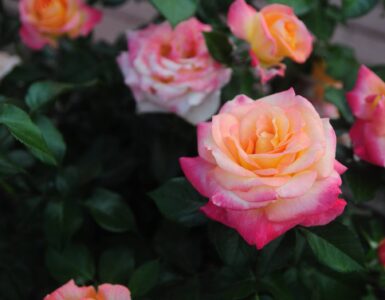Add these easy to forget areas to your spring cleaning checklist. Consumer educator, Teresa Hunsaker, reveals the five places around the house we forget to clean.
It is spring! Yeah! There is something about spring that just makes us want to “brighten” things up a bit, and so we just can’t help but do some Spring cleaning. Here are some often forgotten areas of our home that definitely need some TLC after a long winter.
Refrigerator coils: While refrigerators are relatively low maintenance, they use a fair amount of electricity to keep your food cold 24/7. The one area of their cleaning that is often overlooked is the condenser coils. Cleaning them once or twice a year helps keep the fridge running more efficiently (saves you about $100/year), reduces safety hazards, and eliminate odors. Here is what you do…
1. Shut off the circuit breaker to cut power to the fridge, and unplug the fridge.
2. Move fridge out away from the wall and locate the coils. They will either be on the back or underneath. There are typically two sets of coils. One contains a gas and the other a liquid and they are operated through a compressor that removes heat for cooling. If located on the bottom of the fridge, the access panel will need to be removed to allow you to access the coils. You may want to clean this cover as well.
3. Using a vacuum, soft brush, or clean rag, clean the coils as gently as you can. Vacuum up the dust and loose dust well. Replace the access panel if you have one.
4. Replace the fridge, plug back in, and turn back on the circuit.
Note: Coil brushes for cleaning underneath coils can be found at most hardware/home stores.
Garbage disposal: Cleaning your garbage disposal is another way to keep your household odors at bay. That is because the inside cylinder of the disposal can quickly get a buildup of sludge and little particles of food. Here are some cleaning tips: (While there are commercial disposal cleaners…these work great!)
1. Run a couple of cups of ice mixed with a cup of rock salt.
2. Clear the disposal line by filling the sink about 3 inches with very hot water and a bit of dish detergent. Then unplug the drain and let water run out while at the same time running the disposal. OR,
3. Place ½ cup baking soda in the disposal. Follow that up with 1 cup vinegar. Allow it to work its magic…it will bubble and fizz for a while. Then follow up with some very hot water.
4. Clean the black splash guard by using a rag or soft brush, some water, and a little bleach. This splash guard harbors lots of “bugs” that not only produce an odor, but are not safe.
Note: If you are going to have to place your hands in the disposal cylinder for any reason, cut the power to the disposal by turning off the circuit breaker.
Ceiling fans: Sometimes ceiling fans are so up above our heads that we don’t give them a second thought, but they do collect quite a bit of dust and particles, and need to be cleaned every now and then. Here are some different ways to do that:
1. Purchase a telescoping tool that has a microfiber pad or ceiling fan duster on it.
2. Use a pillow case that you spray the inside with a dust spray and wipe the blades down as you pull the pillowcase off.
3. Use a damp rag and wipe down and rinse each blade. Always dust off the blades first, then follow up with a mild detergent solution on a rag.
4. Use an upholstery brush attachment for your vacuum and vacuum the ceiling fan blades and base.
At least once a year clean the fan base and light fixtures on the fan. This may require taking the fan down, but not always….depending on the style of the fan.
Stove hood and vent/filter: This is another area of the house that really harbors odors and should be cleaned regularly, especially the filter. The hood performs some important functions, like removing smoke, greasy air, and cooking steam/odors, so should not be overlooked. First, let’s tackle the filter. Here are a couple of different and effective ways to clean the filter:
1. Remove the filter and place it in the dishwasher. Use the regular amount of dishwashing detergent and run through a normal cycle. OR,
2. Remove the filter and place in a large pan of boiling water with about ½ to a cup of baking soad added. When the water first starts to boil it will fizz a great deal, so be sure the pan is big enough to allow for this. It will subside quickly, then place your oven vent filter in the water and continue to boil. The buildup will be quite evident in the pan as it is released from the filter.
3. On a large jelly roll pan place a few layers of newsprint, then sit the vent filter on the newsprint. Place the pan and filter in the oven at 250°F for about an hour. The grease will melt right off. Then you can wash filter in the sink with soapy water or run it through the dishwasher as noted above. OR,
4. Place filter in a sink filled with hot water and 2 cups ammonia….while it does stink, it works really well. Let sit at least an hour, lightly scrub, and rinse.
Others have found those products like Greased Lightening works well, or a non-foaming oven cleaner, or even an engine degreaser from the automotive department.
For cleaning the hood itself, both top and under side, just a standard cleaner like Greased Lightening, Simple Green, or 409 work great, but so does soap and water with a little bit of ammonia added to it. These solutions should be placed on a damp rag and wiped onto the surface. They can also be used to clean the fan and the light bulb…but be sure to follow up with a clean damp cloth. Clean only the underside of the hood when the light and fan are off. J
Microwave: Food splatters from microwaving food not only look bad, but they smell bad. One of the easiest ways to clean the interior of your microwave is to boil water that has a little bit of baking soda added to the bowl of water. Once the water has boiled about 4-5 minutes leave the door closed and let sit another 5 minutes. Then wipe down the interior with a clean damp cloth. This should take most of the spills and splatters off.
You can also use vinegar or lemon juice in the water rather than the soda.















Add comment